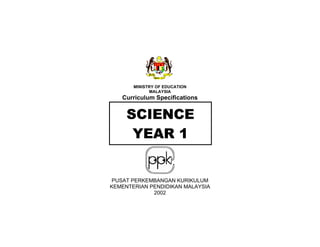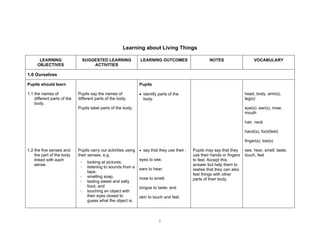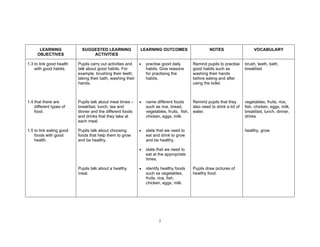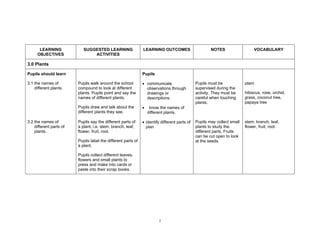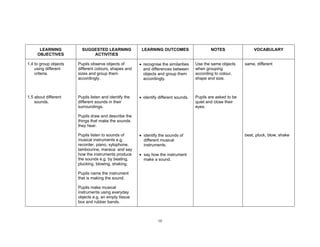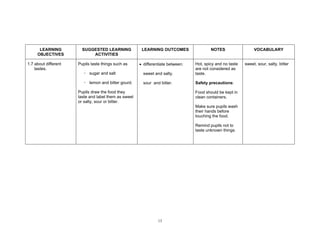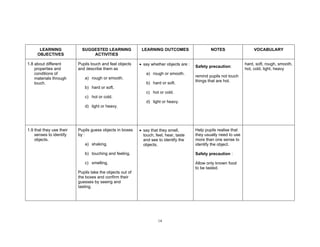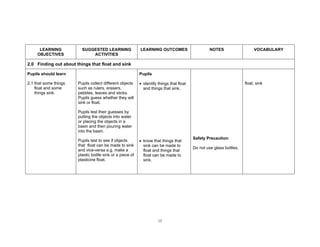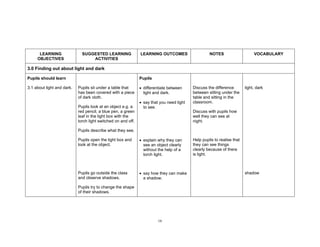Hsp sc y1
- 1. MINISTRY OF EDUCATION MALAYSIA Curriculum Specifications PUSAT PERKEMBANGAN KURIKULUM KEMENTERIAN PENDIDIKAN MALAYSIA 2002 SCIENCE YEAR 1
- 2. 1 Learning about Living Things LEARNING OBJECTIVES SUGGESTED LEARNING ACTIVITIES LEARNING OUTCOMES NOTES VOCABULARY 1.0 Ourselves Pupils should learn Pupils 1.1 the names of different parts of the body. Pupils say the names of different parts of the body. Pupils label parts of the body. âĒ identify parts of the body. head, body, arm(s), leg(s) eye(s), ear(s), nose, mouth hair, neck hand(s), foot(feet) finger(s), toe(s) 1.2 the five senses and the part of the body linked with each sense. Pupils carry out activities using their senses, e.g. looking at pictures. listening to sounds from a tape. smelling soap. tasting sweet and salty food, and touching an object with their eyes closed to guess what the object is. âĒ say that they use their : eyes to see; ears to hear; nose to smell; tongue to taste; and skin to touch and feel. Pupils may say that they use their hands or fingers to feel. Accept this answer but help them to realise that they can also feel things with other parts of their body. see, hear, smell, taste, touch, feel
- 3. 2 LEARNING OBJECTIVES SUGGESTED LEARNING ACTIVITIES LEARNING OUTCOMES NOTES VOCABULARY 1.3 to link good health with good habits. Pupils carry out activities and talk about good habits. For example, brushing their teeth, taking their bath, washing their hands. âĒ practise good daily habits. Give reasons for practising the habits. Remind pupils to practise good habits such as washing their hands before eating and after using the toilet. brush, teeth, bath, breakfast 1.4 that there are different types of food. Pupils talk about meal times â breakfast, lunch, tea and dinner and the different foods and drinks that they take at each meal. âĒ name different foods such as rice, bread, vegetables, fruits, fish, chicken, eggs, milk. Remind pupils that they also need to drink a lot of water. vegetables, fruits, rice, fish, chicken, eggs, milk, breakfast, lunch, dinner, drinks 1.5 to link eating good foods with good health. Pupils talk about choosing foods that help them to grow and be healthy. âĒ state that we need to eat and drink to grow and be healthy. âĒ state that we need to eat at the appropriate times. healthy, grow Pupils talk about a healthy meal. âĒ identify healthy foods such as vegetables, fruits, rice, fish, chicken, eggs, milk. Pupils draw pictures of healthy food.
- 4. 3 LEARNING OBJECTIVES SUGGESTED LEARNING ACTIVITIES LEARNING OUTCOMES NOTES VOCABULARY 2.0 Animals Pupils should learn Pupils 2.1 the names of different animals Pupils look at pictures and name the different animals, e.g. cat, dog, cow, goat, fly, butterfly, ant, fish, bird, snake, frog. Pupils match animals to their names Pupils imitate animal sounds and movements. Pupils make animals using playdough. âĒ know the names of different types of animals. Use flash cards. A cow moos, a bird tweets, a snake hisses, a frog croaks a butterfly flies, a snake glides, a frog jumps How to make playdough: 1 cup flour 1 cup fine salt enough water to dissolve the salt 1 teaspoon cream of tartar 1 tablespoon cooking oil food colouring Method: 1. Mix all ingredients in a bowl. 2. Knead the mixture into a dough. animal cat, dog, cow, goat, fly, butterfly, ant, fish, bird, snake, frog moos, tweets, hisses, croaks flies, glides, jumps
- 5. 4 LEARNING OBJECTIVES SUGGESTED LEARNING ACTIVITIES LEARNING OUTCOMES NOTES VOCABULARY 2.2 the names of different parts of animals. Pupils look at pictures and say the different parts of animals e.g. eyes, ears, nose, beak, mouth, wing, legs, tail, fins, horn. Pupils complete pictures of animals by drawing the missing animal parts. âĒ identify different parts of animals. eyes, ears, nose, beak, mouth, wing, legs, tail, fins, horn Pupils label the different parts of animals. 2.3 where animals live. Pupils walk around the school compound to look at animals. Pupils draw and talk about what they see during their walk. Pupils talk about where different animals live e.g. house, farm, field, tree, grass, pond, soil, forest. âĒ communicate observations through drawing or descriptions. âĒ state where different animals live. Pupils must be supervised during the walk around the school compound. Remind them not to touch any animals or disturb the places they live. house, farm, field, tree, grass, pond, soil, forest Pupils look at pictures and match animals to their homes.
- 6. 5 LEARNING OBJECTIVES SUGGESTED LEARNING ACTIVITIES LEARNING OUTCOMES NOTES VOCABULARY 3.0 Plants Pupils should learn Pupils 3.1 the names of different plants. Pupils walk around the school compound to look at different plants. Pupils point and say the names of different plants. Pupils draw and talk about the different plants they see. âĒ communicate observations through drawings or descriptions. âĒ know the names of different plants. Pupils must be supervised during the activity. They must be careful when touching plants. plant hibiscus, rose, orchid, grass, coconut tree, papaya tree 3.2 the names of different parts of plants. Pupils say the different parts of a plant, i.e. stem, branch, leaf, flower, fruit, root. Pupils label the different parts of a plant. Pupils collect different leaves, flowers and small plants to press and make into cards or paste into their scrap books. âĒ identify different parts of plan Pupils may collect small plants to study the different parts. Fruits can be cut open to look at the seeds. stem, branch, leaf, flower, fruit, root
- 7. 6 LEARNING OBJECTIVES SUGGESTED LEARNING ACTIVITIES LEARNING OUTCOMES NOTES VOCABULARY 3.3 that plants need water to grow. Pupils look at a wilted plant and suggest reasons why the plant has wilted. They suggest how the wilted plant can be revived. Pupils test their answers, e.g. by watering the plant. After some time, pupils observe and say what happens. âĒ state that plants need water to grow. Accept all the reasons suggested by pupils and have them test the answers. water 3.4 that plants need sunlight to grow. Pupils look at two plants, one that has been kept in the cupboard and another by a window. Pupils suggest reasons for the differences in the appearance of the plants. They suggest how the plant which has been kept in the cupboard can be revived. Pupils test their answers, e.g. placing the plant outside the classroom. After a some time, pupils observe and say what happens. âĒ state that plants need sunlight to grow. Accept all the reasons suggested by pupils and have them test the answers. sunlight
- 8. 7 LEARNING OBJECTIVES SUGGESTED LEARNING ACTIVITIES LEARNING OUTCOMES NOTES VOCABULARY 3.3 that plants grow. Pupils grow plants from seeds, e.g. balsam, green bean, chilly. Pupils look after and observe the seedlings daily. Pupils record their observations in the form of drawings. âĒ state that plants grow by comparing the height and number of leaves. âĒ communicate observations through drawings and descriptions. Pupils use strips of paper to show difference in height. seed, taller, more
- 9. 8 Learning about the World around Us LEARNING OBJECTIVES SUGGESTED LEARNING ACTIVITIES LEARNING OUTCOMES NOTES VOCABULARY 1.0 Using our Senses Pupils should learn Pupils 1.1 about different colours. Pupils walk around the school compound and identify as many objects of different colours as possible e.g. a purple flower, a green leaf, a red car, a blue dress. Pupils group objects according to their colours. Pupils create a collage using different coloured seeds and spices. âĒ identify different colours. red, blue, green, yellow, white, black, purple, brown, orange, pink
- 10. 9 LEARNING OBJECTIVES SUGGESTED LEARNING ACTIVITIES LEARNING OUTCOMES NOTES VOCABULARY 1.2 about different shapes. Pupils walk around the school compound and identify as many objects of different shapes as possible e.g. a round tyre, a rectangular sign post, a square frame, a triangular shaped roof. Pupils group objects according to their shapes. Pupils create a picture or a model using different shapes and colours. âĒ identify different shapes. The picture can be in the form of a drawing or collage. The model can be in the form of playdough model or origami. triangle, square, rectangle, circle 1.3 about different sizes. Pupils look around the classroom and identify small and big objects. Pupils identify animals and group them into big animals and small animals. âĒ differentiate sizes : big and small. big, small
- 11. 10 LEARNING OBJECTIVES SUGGESTED LEARNING ACTIVITIES LEARNING OUTCOMES NOTES VOCABULARY 1.4 to group objects using different criteria. Pupils observe objects of different colours, shapes and sizes and group them accordingly. âĒ recognise the similarities and differences between objects and group them accordingly. Use the same objects when grouping according to colour, shape and size. same, different 1.5 about different sounds. Pupils listen and identify the different sounds in their surroundings. Pupils draw and describe the things that make the sounds they hear. âĒ identify different sounds. Pupils are asked to be quiet and close their eyes. Pupils listen to sounds of musical instruments e.g. recorder, piano, xylophone, tambourine, maraca and say how the instruments produce the sounds e.g. by beating, plucking, blowing, shaking. Pupils name the instrument that is making the sound. Pupils make musical instruments using everyday objects e.g. an empty tissue box and rubber bands. âĒ identify the sounds of different musical instruments. âĒ say how the instrument make a sound. beat, pluck, blow, shake
- 12. 11 LEARNING OBJECTIVES SUGGESTED LEARNING ACTIVITIES LEARNING OUTCOMES NOTES VOCABULARY Pupils play musical instruments softly and then loudly. Pupils describe the sounds as soft or loud. âĒ describe sounds. loud, soft Pupils play all the musical instruments at the same time loudly. Pupils describe the sound as noisy. Pupils play a tune together using their instruments. Pupils describe the sound they make. âĒ recognise that some sounds are nice to listen to and some are not Pupils should be warned that loud sounds can damage the ear and disturb other people. noisy, quiet Pupils talk about the use of sounds in the surroundings e.g. siren, alarm, school bell etc. âĒ recognise sounds created for specific purposes.
- 13. 12 LEARNING OBJECTIVES SUGGESTED LEARNING ACTIVITIES LEARNING OUTCOMES NOTES VOCABULARY 1.6 about different smells. Pupils smell things that have been placed inside boxes. Pupils say whether they can smell the things inside the boxes. Pupils open the boxes and say the names of things that have a smell. Pupils group the contents of the boxes into nice and bad smells. âĒ say whether a thing has a smell. âĒ group things according to their smells: nice, bad. Smells are subjective. It is for the child to decide whether a smell is nice or bad. nice smell, bad smell
- 14. 13 LEARNING OBJECTIVES SUGGESTED LEARNING ACTIVITIES LEARNING OUTCOMES NOTES VOCABULARY 1.7 about different tastes. Pupils taste things such as sugar and salt lemon and bitter gourd. Pupils draw the food they taste and label them as sweet or salty, sour or bitter. âĒ differentiate between: sweet and salty. sour and bitter. Hot, spicy and no taste are not considered as taste. Safety precautions: Food should be kept in clean containers. Make sure pupils wash their hands before touching the food. Remind pupils not to taste unknown things. sweet, sour, salty, bitter
- 15. 14 LEARNING OBJECTIVES SUGGESTED LEARNING ACTIVITIES LEARNING OUTCOMES NOTES VOCABULARY 1.8 about different properties and conditions of materials through touch. Pupils touch and feel objects and describe them as a) rough or smooth. b) hard or soft. c) hot or cold. d) light or heavy. âĒ say whether objects are : a) rough or smooth. b) hard or soft. c) hot or cold. d) light or heavy. Safety precaution: remind pupils not touch things that are hot. hard, soft, rough, smooth, hot, cold, light, heavy 1.9 that they use their senses to identify objects. Pupils guess objects in boxes by : a) shaking. b) touching and feeling. c) smelling. Pupils take the objects out of the boxes and confirm their guesses by seeing and tasting. âĒ say that they smell, touch, feel, hear, taste and see to identify the objects. Help pupils realise that they usually need to use more than one sense to identify the object. Safety precaution : Allow only known food to be tasted.
- 16. 15 LEARNING OBJECTIVES SUGGESTED LEARNING ACTIVITIES LEARNING OUTCOMES NOTES VOCABULARY 2.0 Finding out about things that float and sink Pupils should learn Pupils 2.1 that some things float and some things sink. Pupils collect different objects such as rulers, erasers, pebbles, leaves and sticks. Pupils guess whether they will sink or float. âĒ identify things that float and things that sink. float, sink Pupils test their guesses by putting the objects into water or placing the objects in a basin and then pouring water into the basin. Pupils test to see if objects that float can be made to sink and vice-versa e.g. make a plastic bottle sink or a piece of plasticine float. âĒ know that things that sink can be made to float and things that float can be made to sink. Safety Precaution: Do not use glass bottles.
- 17. 16 LEARNING OBJECTIVES SUGGESTED LEARNING ACTIVITIES LEARNING OUTCOMES NOTES VOCABULARY 3.0 Finding out about light and dark Pupils should learn Pupils 3.1 about light and dark. Pupils sit under a table that has been covered with a piece of dark cloth. Pupils look at an object e.g. a red pencil, a blue pen, a green leaf in the light box with the torch light switched on and off. Pupils describe what they see. âĒ differentiate between light and dark. âĒ say that you need light to see. Discuss the difference between sitting under the table and sitting in the classroom. Discuss with pupils how well they can see at night. light, dark Pupils open the light box and look at the object. âĒ explain why they can see an object clearly without the help of a torch light. Help pupils to realise that they can see things clearly because of there is light. Pupils go outside the class and observe shadows. Pupils try to change the shape of their shadows. âĒ say how they can make a shadow. shadow

